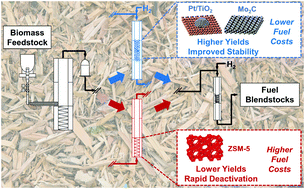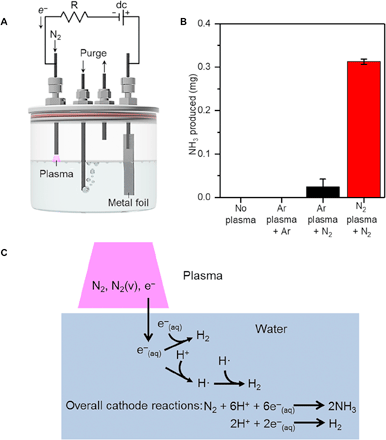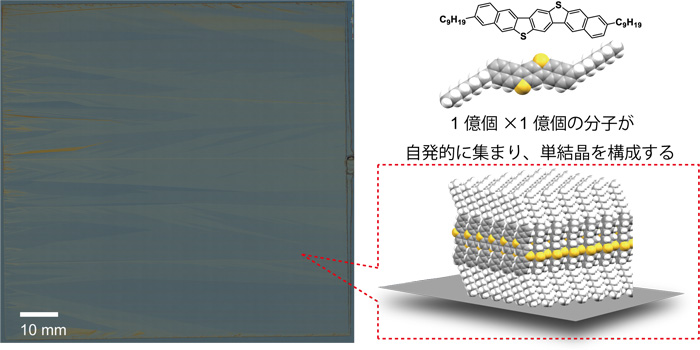(Advancements in Catalytic Fast Pyrolysis Give Biofuels a Boost)
2019/1/8アメリカ合衆国・国立再生可能エネルギー研究所(NREL)
・ 米国エネルギー省(DOE)の国立研究所の NREL、パシフィック・ノースウェスト国立研究所(PNNL)およびアルゴンヌ国立研究所(ANL)が率いる R&D コンソーシアムの Chemical Catalysis for Bioenergy (ChemCatBio)が、固定床反応器中での二機能触媒の使用による、触媒を使用した急速熱分解 (catalytic fast pyrolysis: CFP)の新手法を開発。バイオ原油収率増量とコスト低減を実証。
・ CFP の利点の一つは様々なリグノセルロース系バイオマス原料を使用できること。原料の融通性と多様な製品製造の可能性が見込めるバイオリファイナリーであるが、従来の CFP ではライザー反応器でゼオライト触媒を使用。ゼオライトは大量にコークスを形成してバイオ原油の収率を低下させる。
・ 今回実証した CFP プロセスでは、コークスの形成量が減少して反応時間が延長。さらに、従来の標準的プロセスに比して高品質なバイオ原油収率量の大幅な増加を確認した。
・ 新プロセスの技術的・経済的評価の結果では、燃料混合基材に対する炭素利用率が従来の CFP プロセスに比して 50%向上。新プロセスでは高価な白金-二酸化チタン触媒を使用しているが、触媒寿命の延長と炭素収率量の増加が燃料混合基材生成コストの低減をもたらした。
・ また、ライフサイクル分析の結果では、燃料混合基材のサプライチェーン全体における GHGs 排出量がガソリンに比して約 80%低減したことも確認。
・ ChemCatBio コンソーシアムにおいて、NREL は CFP プロセスの改良、精留・燃料試験および技術経済分析を担当。PNNL はバイオ原油を水素化し、追加プロセスのため NREL に返送。ANL はライフサイクル・環境評価を実施。ChemCatBio の協力体制ではまた、触媒組成の正確な選択を支援する新開発の触媒コスト概算ツールの『CatCost』を活用。
・ 同新プロセスの経済的・環境的な利点に加え、この種類の触媒で統合的なバイオマス・ツー・混合基材生成プロセスを実証したのは今回が初めてとなる。最終的な混合基材製品の分析の結果、燃料として単独使用に適う特性は持たないが石油由来燃料との混合に適するという、未知の技術的課題が判明した。
・ 最適化を目指しさらに研究を進めることで、同 CFP プロセスのさらなる性能向上とコスト削減が可能と考える。今回原料に使用したパイン材を森林残渣や一般廃棄物等にすることでコストの削減を図る。
URL: https://www.nrel.gov/news/program/2019/advancements-in-catalytic-fast-pyrolysis-give-bi ofuels-a-boost.html
(関連情報)
Energy & Environmental Science 掲載論文(アブストラクトのみ:全文は有料)
Driving towards cost-competitive biofuels through catalytic fast pyrolysis by rethinking catalyst selection and reactor configuration
URL: https://pubs.rsc.org/en/Content/ArticleLanding/2018/EE/C8EE01872C#!divAbstract
<NEDO海外技術情報より>
Abstract
Catalytic fast pyrolysis (CFP) has emerged as an attractive process for the conversion of lignocellulosic biomass into renewable fuels and products. Considerable research and development has focused on using circulating-bed reactors with zeolite catalysts (e.g., HZSM-5) for CFP because of their propensity to form gasoline-range aromatic hydrocarbons. However, the high selectivity for aromatics comes at the expense of low carbon yield, a key economic driver for this process. In this contribution, we evaluate non-zeolite catalysts in a fixed-bed reactor configuration for an integrated CFP process to produce fuel blendstocks from lignocellulosic biomass. These experimental efforts are coupled with technoeconomic analysis (TEA) to benchmark the process and guide research and development activities to minimize costs. The results indicate that CFP bio-oil can be produced from pine with improved yield by using a bifunctional metal-acid 2 wt% Pt/TiO2 catalyst in a fixed-bed reactor operated with co-fed H2 at near atmospheric pressure, as compared to H-ZSM5 in a circulating-bed reactor. The Pt/TiO2 catalyst exhibited good stability over 13 reaction-regeneration cycles with no evidence of irreversible deactivation. The CFP bio-oil was continuously hydrotreated for 140 h time-on-stream using a single-stage system with 84 wt% of the hydrotreated product having a boiling point in the gasoline and distillate range. This integrated biomass-to-blendstock process was determined to exhibit an energy efficiency of 50% and a carbon efficiency of 38%, based on the experimental results and process modelling. TEA of the integrated process revealed a modelled minimum fuel selling price (MFSP) of $4.34 per gasoline gallon equivalent (GGE), which represents a cost reduction of $0.85 GGE−1 compared to values reported for CFP with a zeolite catalyst. TEA also indicated that catalyst cost was a significant factor influencing the MFSP, which informed additional CFP experiments in which lower-cost Mo2C and high-dispersion 0.5 wt% Pt/TiO2 catalysts were synthesized and evaluated. These materials demonstrated CFP carbon yield and oil oxygen content similar to those of the 2 wt% Pt/TiO2 catalyst, offering proof-of-concept that the lower-cost catalysts can be effective for CFP and providing a route to reduce the modelled MFSP to $3.86–3.91 GGE−1. This report links foundational science and applied engineering to demonstrate the potential of fixed-bed CFP and highlights the impact of coupled TEA to guide research activities towards cost reductions.



